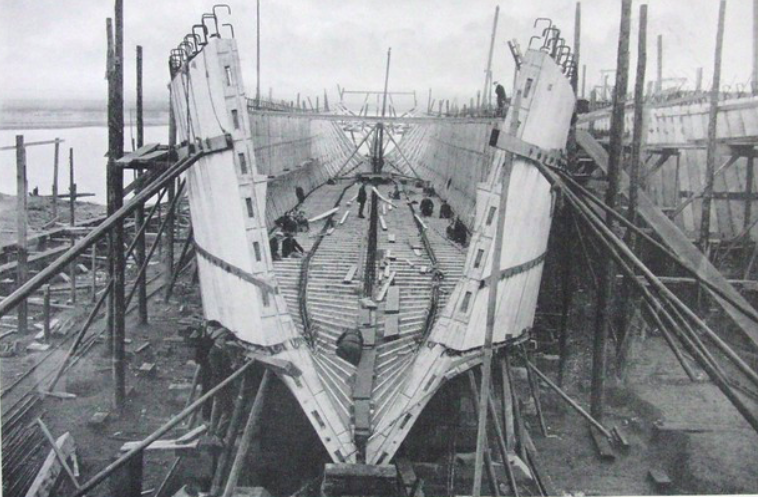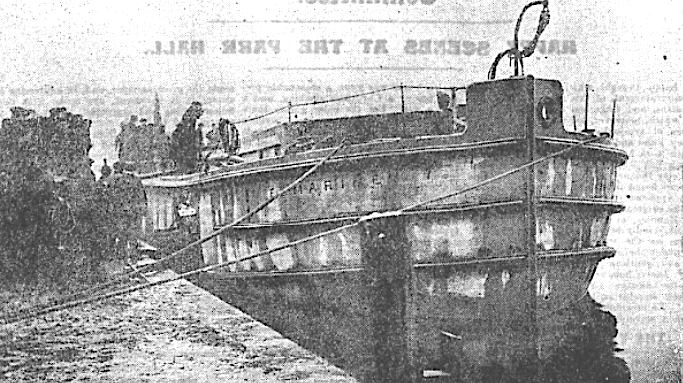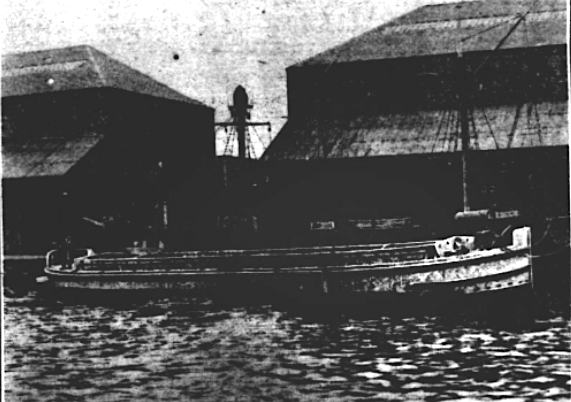
Elmarine after launching:

Ferro-concrete barge Elmarine built 1919 at Fiddler's Ferry, Penketh.
Built from pre-formed concrete modules - Richie Unit System - so lighter
with concrete only 1.75 inch thick.
95 x 21.4 x 8 ft, 230 tons [MNL gives 158 tons]. ON 140629. Listed in MNL under "sail".
No evidence of auxiliary engine in MNL or Casualty returns.
Owned Concrete Seacraft Ltd [builders], then Liverpool Grain Storage
& Transit Co., Brunswick St., Liverpool.
Sank on voyage Birkenhead to Preston with grain on 5 December 1919 in
Crosby Channel. Lifted and beached on 25 June 1920. Still listed in 1947.
Reported to have been used to support grounding location at Llanerch y Mor
for "fun ship" Duke of Lancaster
in 1979 - no longer visible.
Widnes Examiner - Saturday 11 January 1919:
Elmarine launch
A record in the building of ferro-concrete ships was broken at the
yard of the Concrete Seacraft Co.. Ltd., Fiddler's Ferry, on Saturday,
in the launch of the "Elmarine." the lightest seagoing concrete barge
in the world. Notwithstanding the very inclement weather there was a big
crowd at the company's slips at the Ferry, and the launch, which was
a complete success, created much enthusiasm amongst the workpeople at
the yard, which is situated between the Sankey and St. Helens Canal
and the River Mersey.
The "Elmarine," as we have stated, is
claimed to be the lightest concrete boat of her size which has been built
receiving Lloyd's classification. The thickness of the sides is only
1.75 inches, instead of 3.5 inches, which is the requirement for Lloyd's
for boats built in any other method. She is 230 tons, designed for
the local wheat-carrying trade, is 95ft. in length, 21ft. 4in. beam, and 8ft.
draught. In her construction, somewhat novel methods have been
adopted, the designer being Mr. H. C. Ritchie, - of the firm of Messrs.
Ritchie and Black, engineers, Royal Liver Building, Liverpool.
Instead of being built in one mould, into which is poured the concrete
which forms the frame and plates of the finished ship, she was
constructed of a large number of small matured units of concrete
prepared beforehand, and then erected on the slip in much the same
way as the frame and plate of an ordinary steamship. The units of
concrete are fixed by means of diagonals of round steel, which bind
the whole structure together.
The successful working of the invention
speaks well for the enterprise, courage and skill of designers
and builders alike. One outstanding advantage of the system is
that the builders are, to a great extent, independent of weather
vagaries; as a large proportion of the work can always be proceeding
under cover. Nowadays, when the need for the repair of the ravages of war upon
our vessels is so great, the ferro-concrete method of construction is
deservedly prominent. The yard at Fiddler's Ferry is one of a number
established at the instigation of the Admiralty, and the company are
now building ten 1000 ton barges. Four of the ships are already fairly well
advanced, and there is a prospect of several launches in the near
future. It is stated to be quite practicable to build such vessels in
two months.
A ferro-concrete barge under construction at Fiddler's Ferry - possibly the Elmarine.

Elmarine after launching:

Liverpool Daily Post - Monday 08 December 1919: Sinking: ELMARINE. Liverpool. Dec.5. Mersey Docks and Harbour Board report under yesterday's date:- Concrete barge Elmarine lies sunk about 150 yards NE magnetic of C2 Red Conical Gas buoy in the Crosby Channel. The barge left Liverpool on the 5th inst. for Preston.
Liverpool Journal of Commerce - Thursday 01 July 1920:
Salvage: ELMARINE. Dock Board advise: Barge Elmarine, which sunk in the Channel last
December, was lifted and placed on Tranmere Beach on the 25th inst.
(Liverpool. June 30.)

Liverpool Journal of Commerce - Thursday 05 August 1920:
The above is an illustration of the 250 ton reinforced concrete
seagoing barge Elmarine, lying in dock after her salvage following
over seven months submersion. She is a pioneer craft as she was the
first vessel built what is known as "The Ritchie Unit System," being
the invention of a Liverpool engineer.
The Elmarine was built early in 1919, and engaged in trade between the
Mersey and Preston. In November last, when carrying a full cargo of
grain, she encountered very heavy weather at the Bar, and as a result
of bursting of her timber hatch covers, she foundered in deep water.
After lying for seven months on what was a very bad bottom, she has
been lifted, and as will be observed, is in excellent condition. The
salvage operations were a very severe test, as she was loaded with
what remained of her cargo and a large quantity of silt in her hold.
Under these severe conditions, the lifting wires only slightly damaged
the concrete hull at two points and so afforded a very striking
example of the punishment a concrete craft will stand.
To quote from the salvage experts reports to underwriters: "There does
not appear to be any signs of severe straining, and very few cement cracks,
which we consider is somewhat remarkable after being submerged for
over seven months and having to stand the strain of lifting and
beaching."
Owing to tidal conditions, the salvage operations involved a
repetition of lifting and beaching several times, so that successful
results give evidence of the exceptional strength of concrete vessels.
The small repairs to the concrete where lightly damaged will involve
almost negligible expense, and the greatest cost of reconditioning
will be the painting of those parts and fittings which were steel or
iron and the renewal of the timber hatch covers.
It is understood that there are another dozen larger and smaller craft
built on The Richie System of reinforced concrete now in service, all
built since the Elmarine, and owners are greatly satisfied with them.
They remark mainly upon the surprisingly low upkeep costs, which are
stated to be not more than one fifth of those of similarly sized steel
craft.
The Ritchie Concrete Engineering and and Shipbuilding Company Limited
are now building at their Preston shipyard, motor coasters from 300
tons up to 1000 tons d.w. in addition to several smaller craft in the
shape of dumb barges.